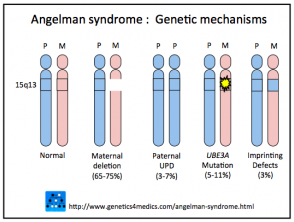What is angelman? syndrome?
Angelman syndrome is rare neurological disorder that occurs in 1 in every 15,000 births and in the past, was confused with other disorders such as cerebral paralysis or autism. It is marked by a complex training of the symptoms
It was named for Dr. Harry Angelman, who first described the disorder in 1965.
Who gets Angelman syndrome?
Angelman syndrome is rare:
- Most people with Angelman syndrome have no family history.
- In a small percentage of cases, the syndrome can be inherited from a parent
- There are no racial or sexual preferences noted in the medical literature.
What causes Angelman syndrome?
Angelman syndrome is genetic in origin. Genetic changes can be random, that is, without a family history of the disorder.
- It is due to the loss of expression of the maternal copy of UBE3A gene Located in chromosome 15q11.2-q13OCA2.
- The deletion occurs at 65-75%
- maternal gene mutations affect 5–11%
- Paternal uniparental disomy (pUPD, meaning both copies are from the father) affects 3–7%
- Maternal imprinting defect occurs in 3%
Prader-Willi syndrome is a clinically distinct disorder due to a paternally derived defect mapped to the same chromosome as Angelman syndrome.
Genetics of Angelman syndrome*

Genetics of Angelman syndrome
* Image courtesy of Genetics 4 Medics
What are the clinical characteristics of Angelman syndrome?
Cutaneous Characteristics of Angelman syndrome include:
- Hypopigmented skin
- Ocular cutaneous albinism
- Choroid deficiency pigment
- incomplete melanization of melanosomes
- light blue iris
- Decrease in retinal pigment.
- Bass hair bulb tyrosinase exercise
Non-cutaneous features of Angelman syndrome include seizures, developmental delays, limited or no speech, mobility disorders, increased smiling, a happy and excitable personality, hand flapping, abnormal sleep cycles, and microcephaly.
How is Angelman syndrome treated?
There is no cure for Angelman syndrome. Lifelong care is needed and treatment focuses on controlling symptoms. May include:
- Anticonvulsant medications (including sodium valproate alone or with clonazepam or another benzodiazepine)
- Communication therapy to instruct children to use sign language or images
- Behavioral therapy to help treat short attention spans and hyperactivity
What is the result of Angelman syndrome?
Despite many limitations, the life expectancy of patients with Angelman syndrome is normal. Often, patients will become less excitable as they age and outgrow sleep cycle abnormalities.

